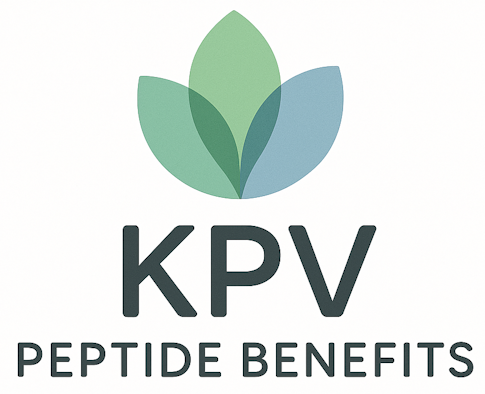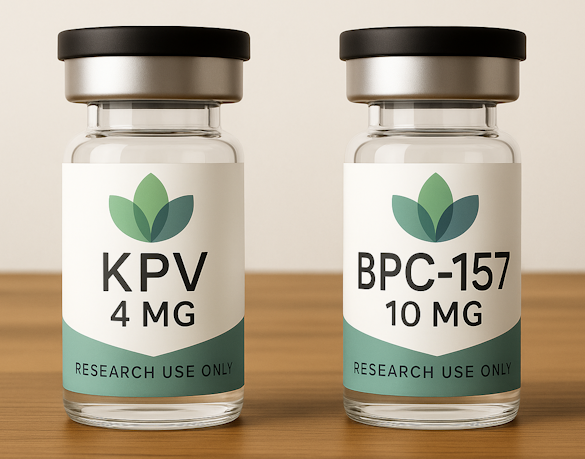The comparison of KPV peptide vs BPC 157 has gained major attention in the world of peptide therapy due to their shared ability to promote gut health, reduce chronic inflammation, and accelerate tissue repair, highlighting their individual benefits. While both peptides show remarkable healing properties, their mechanisms, origins, and use cases differ.
KPV peptide is a synthetic peptide derived from the alpha melanocyte stimulating hormone, known for its potent anti-inflammatory and immune-regulating abilities. BPC 157, short for Body Protection Compound-157, is a naturally occurring protein fragment originally found in human gastric juice. It supports gut health, enhances tissue healing, and promotes new blood vessel growth within the digestive tract, gut lining, and connective tissues.
Understanding the difference between these two peptides helps clarify how each supports the body’s natural healing and recovery processes — particularly for people struggling with digestive issues, leaky gut joint pain, or inflammatory bowel disease.
For an in-depth breakdown of how KPV works at the molecular level, see our article on KPV peptide mechanism of action and clinical research.
Origins and Structure
KPV peptide is a synthetic peptide composed of three amino acids—lysine, proline, and valine—derived from the alpha melanocyte stimulating hormone. This short-chain molecule plays a key role in regulating immune responses and calming inflammation.
BPC 157, on the other hand, is a naturally occurring protein fragment containing 15 amino acids that supports cellular repair, isolated from gastric juice. As part of the Body Protection Compound, it contributes to gut lining integrity and supports tissue regeneration.
In short, KPV peptide targets inflammation control, while BPC 157 focuses on healing and regenerative properties within the gut and throughout the body.
Mechanisms of Action
Both peptides work at the cellular level to promote healing, but through distinct mechanisms.
KPV peptide interacts with the immune system by suppressing inflammatory cytokines and inflammatory responses that drive chronic inflammation and intestinal inflammation. By binding to melanocortin receptors, it helps the body regulate immune function and reduce inflammation, leading to improved gut health and overall wellness.
BPC 157, in contrast, enhances blood vessel growth, boosts cellular repair, and stimulates tissue regeneration. This naturally occurring peptide helps maintain the intestinal barrier and reduces damage to the gut lining caused by leaky gut or inflammatory conditions like ulcerative colitis and Crohn’s disease.
Through these complementary mechanisms, both peptides deliver anti-inflammatory benefits and contribute to faster recovery and comprehensive healing throughout the body.
Gut Health and Digestive Benefits
Among the most discussed benefits of peptide therapy, gut health remains central to both KPV peptide and BPC 157.
KPV peptide primarily reduces gut inflammation by targeting pro-inflammatory cytokines in the intestinal lining. This action helps protect the gut barrier, easing symptoms linked to inflammatory bowel disease and irritable bowel syndrome. By promoting anti inflammatory pathways, KPV reduces inflammation and aids the body’s natural processes of healing and tissue repair.
Meanwhile, BPC 157 plays a broader role in supporting gut health. Known to accelerate healing of the stomach lining and digestive tract, it has shown in preclinical studies and animal models to enhance the gut lining’s integrity and reduce inflammation caused by leaky gut. It not only improves digestion but also assists in calming inflammation, strengthening the intestinal barrier, and promoting new blood vessel growth that supports gut recovery.
For people struggling with digestive issues, both peptides offer distinct yet synergistic effects that enhance gut health, improve nutrient absorption, and shorten recovery time. For guidance on research-based dosing and delivery methods, review our KPV Peptide Dosage Chart.
Healing and Regenerative Properties
Both peptides are celebrated for their remarkable healing properties and strong anti inflammatory properties, but their specific focus areas differ.
KPV peptide primarily acts on inflammatory skin conditions, intestinal inflammation, and chronic inflammation of the gut. Its anti inflammatory nature allows it to reduce inflammation at the cellular level, aiding in wound healing and tissue healing.
BPC 157 is more regenerative, promoting new blood vessel growth, accelerates tissue repair, and stimulates tissue regeneration across muscles, tendons, and ligaments. Its ability to support healing in connective tissues makes it popular among fitness enthusiasts and athletes seeking faster recovery after intense training or injury.
Together, these peptides demonstrate how peptide therapy can provide a comprehensive approach to recovery, healing, and inflammation reduction throughout the body.
KPV Peptide vs BPC-157 Comparison Chart
| Feature | KPV Peptide | BPC-157 |
|---|---|---|
| Structure & Origin | Synthetic peptide derived from alpha melanocyte stimulating hormone; composed of short chains of amino acids | Naturally occurring protein fragment from gastric juice (Body Protection Compound) |
| Primary Focus | Calming inflammation, regulating immune responses, and improving gut lining integrity | Accelerating tissue repair, promoting new blood vessel growth, and enhancing digestive tract healing |
| Mechanism of Action | Modulates inflammatory cytokines and reduces intestinal inflammation via melanocortin receptors | Stimulates angiogenesis, cellular repair, and connective tissue regeneration |
| Dosage Range | Typically 250–500 mcg daily (oral capsule or injection) | 200–500 mcg daily depending on severity and use case |
| Side Effects / Risks | Rare digestive issues or mild irritation | Minimal side effects, occasional nausea or stomach discomfort |
| Use Cases | Gut inflammation, inflammatory bowel disease, inflammatory skin conditions, and immune regulation | Leaky gut, ulcerative colitis, Crohn’s disease, joint pain, wound healing, and tendon recovery |
Dosage and Administration
Both KPV peptide and BPC 157 can be taken as part of a peptide therapy regimen designed to enhance gut health and reduce inflammation.
KPV peptide is often taken as one capsule daily or administered via microgram injections. It’s a synthetic peptide that primarily supports immune system balance, inflammation control, and healing in the digestive tract.
BPC 157 is available in oral capsules and injections. Doses range from 200 to 500 mcg per day, depending on individual goals. It’s especially beneficial for restoring gut lining, aiding tissue repair, and improving joint pain and connective tissue injuries.
When used properly, both peptides can accelerate healing, enhance recovery time, and strengthen the body’s natural ability to recover from inflammation and injury.
Side Effects and Safety
Both KPV peptide and BPC 157 are well-tolerated, with few reported side effects in preclinical studies.
Possible side effects of KPV peptide may include mild digestive issues or sensitivity in people with underlying allergies. BPC 157 may occasionally cause slight nausea but is generally regarded as safe, thanks to its naturally occurring origin and body compatibility.
Because these peptides work at the cellular level, they often produce healing without major disruption to normal immune function or overall wellness.
To learn more about KPV’s safety record and tolerability, visit our KPV Peptide Side Effects guide.
Use Cases and Benefits
KPV peptide is often used by individuals with inflammatory bowel disease, ulcerative colitis, or inflammatory skin conditions, due to its anti inflammatory benefits and ability to reduce inflammation across multiple organ systems.
BPC 157, however, is better suited for leaky gut, joint pain, and tissue regeneration. Its role in blood vessel growth and accelerates tissue repair makes it a go-to solution for athletes and fitness enthusiasts recovering from injury or surgery.
Together, they represent two ends of the same peptide therapy spectrum: one (KPV) emphasizing inflammation control and the other (BPC 157) emphasizing healing and regeneration.
Which Peptide Is Better?
Choosing between KPV peptide and BPC 157 depends on your goals.
If your primary concern is chronic inflammation, gut inflammation, or autoimmune-related gut issues, KPV peptide provides powerful anti inflammatory support and immune system balance.
If your goal is tissue repair and to accelerate recovery, and support healing for muscles, ligaments, or the stomach lining, BPC 157 offers superior regenerative properties and faster recovery.
Both peptides work synergistically when used together, providing a comprehensive approach to healing, gut health, and inflammation reduction at the cellular level.
To find reputable research suppliers offering verified products, see our guide on where to buy KPV peptide online.
Summary
In the discussion of KPV peptide vs BPC 157 as part of peptide therapy, there’s no single “best” option — only the right one for your body and specific health goals. Both peptides deliver measurable benefits in gut health, wound healing, and chronic inflammation recovery.
- KPV peptide offers strong anti inflammatory properties and excels in regulating immune responses and improving intestinal inflammation.
- BPC 157 shines in tissue healing, accelerating recovery, and repairing the gut lining and connective tissues.
Through responsible peptide therapy, users often experience faster recovery, improved overall wellness, and better inflammation control across the body. These peptides embody the future of healing — merging the body’s natural restorative systems with scientifically validated peptides for optimal health and recovery.
Discover their full therapeutic scope on our KPV Peptide Benefits homepage.

